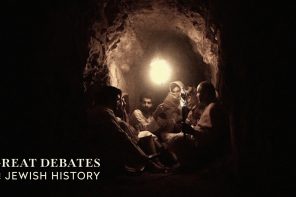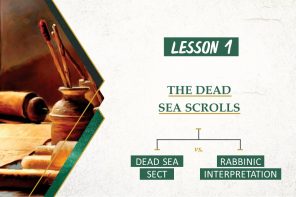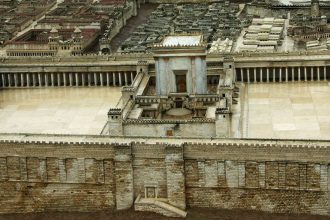Inside Time: A Chassidic Perspective on the Jewish Calendar
Rabbi Yanki Tauber
“You shall count for yourselves from the morrow of the Shabbat, from the day on which you bring the Omer offering, seven complete weeks they shall be; until the morrow of the seventh week, you shall count fifty days…. And you shall proclaim that very day a holy festival….” Leviticus 23:15-21
There was once a people who lived in a deep valley ringed by high mountains. A perpetual mist, trapped by the mountain walls, hung over the valley, allowing only a dim light to penetrate. Generation after generation were born, lived, and died in this gray world.
The old men of the valley told stories of a brighter, warmer world beyond the mountains, a world made joyous and beautiful by a thing called “the sun.” At times, a listener of these stories would be inspired to set out for this sunlit world. But the mountains were steep, the trails treacherous, the maps uncertain, and the goal but a fanciful idea. They all came back empty-handed.
One day, a strong wind forced a breach in the cloud-cover; for a fleeting minute, the valley was flooded with light and warmth. For the first time in their lives, the people of the valley beheld the face of the sun. Then the wind receded, the breach was closed, and once again they were in their familiar, sunless world.
“So this is the sun!” exclaimed the people of the valley. “This is sunlight! This is what it is like to live a life of light, beauty, and joy! We must leave this dark, cold place. We must set out for the sun-blessed world beyond the mountains.”
So the people began climbing out of the valley. The mountains were as steep as ever, the trails as fraught with hardship and uncertainty. But whenever they faltered in their climb, whenever they began to doubt the attainability of their goal, they would remember that moment of sunlight and it would drive them to press on. Inspired and prodded by that vision, they climbed out of the clouds to the world of the sun.
The Climb to Sinai
For 210 years, our ancestors lived in darkness. Enslaved by the Egyptians, the most debased society to ever dwell upon the face of the earth, the children of Israel inhabited a spiritual fog which shut off every vestige of manifest G‑dliness.
Their elders spoke of an age-old promise, made by the G‑d of their fathers, that they would one day leave this sunless world. They spoke of a mountain top upon which G‑d would show Himself to them, take them to Him as His chosen people, and grant them His Torah, the revelation of His wisdom and will. They spoke of a land, basking in the light of divine providence, in which they would fulfill their destiny as “a light unto the nations.”
But this was little more than a fantasy. The darkness of their world seemed impregnable. They had no idea what this place in the sun was like, much less how to get there.
Then, at the stroke of midnight on Nissan 15, 2448 (1313 bce), a breach opened up in the clouds of their exile and they beheld the face of their Creator. On that night, “the Holy One, Blessed be He, revealed His very self to them and redeemed them.”[i]
G‑d, of course, could have simply lifted them out of Egypt and brought them to Mount Sinai that very night. But He wanted it to be their journey, their achievement. So after that momentary vision, the face of G‑d receded.
Then began the arduous climb to Sinai. The Jews were out of Egypt, but Egypt was still deeply imbedded within the Jews. For seven weeks they struggled to refine the seven traits of their souls, to cleanse it of the profanity of Egypt and make themselves worthy candidates for the divine choice.
This was something that they had to achieve on their own, in the darkness of their deficiencies and the coldness of their alienation. But it was that initial vision of the divine light that inspired, encouraged and drove them in their journey.
Each year, on the first night of Passover, we commemorate the events of the night of the Exodus. Through the Seder observances, we reexperience the liberating vision which drives our annual emergence from our personal “Egypt” and our internal liberation “from slavery to freedom, from darkness to a great light.”[ii]
But the revelation of the Exodus is but a brief, momentary flash. On the following day we begin our 49-day trek to Sinai, reenacted each year with the “Counting of the Omer.”[iii] Beginning with the second night of Passover, we count the days traversed from the Exodus, chronicling the milestones and stations of our journey of self-refinement.
The 50th day is the festival of Shavuot, our annual reexperience of the Giving of the Torah, when we once again stand at Sinai to receive G‑d’s communication of His wisdom and will and be chosen as His very own “kingdom of priests and a holy nation.”[iv]
Days and Weeks
In commanding us to count the days from Passover to Shavuot, the Torah instructs:
You shall count for yourselves from the morrow of the Shabbat, from the day on which you bring the Omer offering, seven complete weeks they shall be; until the morrow of the seventh week, you shall count fifty days…. And you shall proclaim that very day a holy festival….
In other words, not only the days, but also the weeks are to be counted. Thus, on the seventh day of the count we say, “Today is seven days, which are one week, to the Omer”; on the 25th day we say, “Today is twenty-five days, which are two weeks and three days, to the Omer”; and so on to the last night of the count, when we say, “Today is forty-nine days, which are seven weeks, to the Omer.” Indeed, the very name of the festival that culminates the count, Shavuot, means “weeks,” emphasizing that it is the product of the seven-week count from the second day of Passover.[v]
Kabbalistic teaching explains that there are seven basic impulses in the heart of man: chesed (love and benevolence); gevurah (awe and restraint); tiferet (harmony and compassion); netzach (victory and ambition); hod (humility and devotion); yesod (bonding) and malchut (sovereignty and receptiveness).[vi] Each of these traits includes nuances of all seven (e.g., chesed of chesed, gevurah of chesed, tiferet of chesed, etc.) making a total of forty-nine49 aspects to the human character.[vii]
Thus, the basic journey is one of seven weeks, each devoted to perfecting another of our seven primary attributes. The days are details and aspects of the weeks—a count within a count, a journey within a journey.[viii]
The Contradiction
The Torah’s emphasis on the weeks of the Omer Count gives rise to a seeming contradiction in its instructions as to how the count is to be conducted. The Talmud devotes a lengthy discussion to resolving this inconsistency and arriving at a decisive interpretation of the Torah’s words.
The Torah not only instructs us to count seven weeks from the second day of Passover—it says that these should be “seven complete weeks.” This seems to imply that the count should include seven full calendar weeks, each running from Sunday to Shabbat. This would mean that the festival of Shavuot will always fall on a Sunday—the day after the seventh “complete” week has been concluded.[ix]
The Talmud, however, rejects this hypothesis. For the Torah explicitly instructs, “You shall count fifty days.” Obviously, then, the “complete weeks” of the Omer Count are not the Sunday-to-Shabbat weeks that populate our calendar, but “man-made” weeks—seven-day units created by our count. Otherwise, the count would, in most years, total more than fifty days. (For example, if the first day of Passover occurs on a Tuesday, and we were to insist on seven “complete” Sunday-to-Shabbat weeks, Shavuot will occur on the 54th day of the count.)
But there are certain years, concludes the Talmud, in which the configuration of the calendar is such that there is no inconsistency, and the Torah’s words can be implemented in their most literal sense. When the first day of Passover falls on a Shabbat, the seven weeks of the Omer are “complete” in every sense. They are fully personal weeks, each containing seven days of our individual count; and they are complete calendar weeks, corresponding to the seven-day cycle which G‑d instituted at the very beginning of creation, and which continues to define our experience of time.[x]
The Man-Made Week
But why are the Torah’s instructions expressed so ambiguously, fraught with inconsistency and open to misinterpretation? And why is the Counting of the Omer so structured that in certain years the count is more “complete” than in others?
As explained above, the entire point of the Omer Count is that our journey to Sinai be a personal one, the product of our own efforts. Obviously, no human achievement can equal the perfection of the divine; but that which is granted us from Above, however perfect and infinite, is never as deeply appreciated or as intensely identified with as that which we attain with our own finite capabilities. In the words of the Talmud, “A person would rather have a kav of his own [grain] than nine kavim of his fellow’s.”[xi]
The only truly “complete weeks” are G‑d’s weeks—the weeks that are the product of His original work of creation. Man-made weeks are forever bound by the limitations and deficiencies of their mortal creator. Yet man-made weeks are what connect Passover and the Exodus with Shavuot and Sinai. “You shall count for yourselves,” instructs the Torah. This is your climb, your journey.
Hence the contradiction—an inconsistency built in to the very nature of the Omer count. On the one hand we are striving toward Sinai, toward our election as G‑d’s chosen people. The goal is perfection: the refinement of all seven dimensions of the heart and all their 49 sub-aspects. On the other hand, it is we who are conducting the count, we who are struggling up the steep slopes of our valley, we who compose and define the weeks of the Omer.
The inherent paradox in these two objectives is reflected in the contrary implications in the Torah’s instructions. On the one hand, the Torah insists on seven “complete”—apparently G‑d-made—weeks. On the other hand, it emphasizes that these are to be personal weeks, the product of our count rather than of divine creation.
In truth, however, the Omer Count is a place where the finite and the infinite converge, where divine revelation and human effort combine to move a people toward their encounter with G‑d. For though the actual count begins “on the morrow of the Shabbat”—on the day after the first of Passover—it is driven by the revelation of the Exodus. Though the actual count is conducted in the valley of human subjectivity, it is that original, momentary flash of light that penetrates the darkness of our valley, impels us on our journey, and empowers us to forge upwards and attain the summit.
When Passover Falls on Shabbat
So there are two elements in our every journey: that which we receive and that which we achieve. As we traverse the quests and climbs of life, at times one, at times the other, of these elements dominates, while the other recedes to the background.
At times, the divine influence in our lives dominates. We sense a higher power carrying us along, granting us the understanding and vision with which to meet life’s challenges, and the courage and fortitude to surmount them. At such times, we appreciate that we are part of something greater than ourselves; that our achievements are the outgrowth of a perfection that transcends the human, reflecting the divine source of all our gifts.
At other times, our selfhood and individuality dominate. The divine influence recedes, heightening our sense of our own strengths and weaknesses, of our own responsibility for our failures and successes. We experience difficulty and disappointment, alienation and despair; but also fulfillment, pride, and true identification with our achievements.
Finally, there are those moments, rare and exquisite, when the received and the achieved coalesce in our journey; when our vision of the summit is fully integrated into our struggle up the mountainside. Times when we sense the enormity of what has been revealed and granted to us, and at the same time, fully identify with them. Times when we are not only aware of what is divine and infinite in our lives, but when our experience of these gifts is an intensely personal experience, for we have incorporated them into our self and personality.
The seven weeks of the Omer Count are always “complete weeks”—complete in that they represent the optimum of our personal efforts at self-perfection, and complete in that they are driven by a vision that has the perfection of the divine. Usually, however, these two aspects of “completeness” are in conflict with each other, as an overt emphasis on the divinely granted vision will detract from our sense of fulfillment and identification with our achievements. So the divine input into our lives retreats to the realm of “memory,” “intuition,” and “spiritual experience,” so as to allow for our construction of wholly man-made weeks to join Passover and Shavuot.
But there are certain years in which these man-made weeks coincide with the divinely-ordained weeks of creation. When the first day of Passover falls on Shabbat, each of “our” weeks is also a Sunday-to-Shabbat week, alluding to a special window of opportunity. In these years we are particularly empowered to integrate our divine endowments with our personal achievements.
In these years, our journey from Exodus to Sinai is comprised of “seven complete weeks” in every sense: weeks that combine the perfection of the divinely granted with the depth of the personally achieved.
[i] Passover Haggadah.
[ii] Ibid.
[iii] On the second day of Passover, the day on which the count begins, an omer (approx. 43 oz.) of barley was offered at the Holy Temple in Jerusalem, representing the refinement of the “animal soul” of man (barley being the representative animal food—see I Kings 5:8, and Talmud, Sotah 14a) which is the objective of the count (see The Three Names of Shavuot on pp. ##-##, below).
[iv] Exodus 19:6.
[v]. As a result, Shavuot is the only festival that does not have a fixed calendar date, but is defined as the 50th day of the Omer Count.
(Today we follow a fixed calendar in which the month of Nissan always has 30 days and the month of Iyar, 29 days. Thus, the 50th day of the count, which begins on Nissan 16 [the second night of Passover], always coincides with the 6th of Sivan. However, this is only because today we do not have a functioning Sanhedrin [supreme court of Torah law]. In essence, the Jewish calendar is supposed to be fixed by eyewitness sightings of the new moon, based on which the Sanhedrin proclaims the new month. By this process, which will recommence with the coming of Moshiach and the reestablishment of the Sanhedrin, any month may consist of either 29 or 30 days; Shavuot might thus occur on the 5th, 6th or 7th of Sivan.
But the fact that the true “date” of Shavuot is the 50th day of the Omer rather than the 6th of Sivan can, in certain circumstance, be pertinent today as well. For example, there exists a halachic dilemma in the case of a traveler who crosses the International Date Line during the period between Passover and Shavuot, thereby “gaining” or “losing” a day. Regarding all other festivals, whose dates are determined by the calendar, an individual’s loss or gain of a day is obviously irrelevant. But since Shavuot is defined solely as the 50th day from the second day of Passover, the question arises: Is this traveler to observe Shavuot on his 50th day, or is he to defer to the 50th day as counted by the community with whom he is observing the festival?)
[vi] There are, in fact, ten sefirot, and ten corresponding attributes in the soul of man. The first three (chochmah, binah and da’at) are “intellectual” or perceptual faculties and beyond the scope of the sefirah count, which involves the refinement of the character and emotions.
Each of these attributes are multifaceted and multinuanced, and there are no English words that can be said to capture its essence; thus, each has several translations in contemporary English literature on Kabbalah and Chassidism, depending on the context and the author’s preference. For a comprehensive discussion of these seven attributes as they exist in the human character, and for examples of the seven aspects within each attribute, see A Spiritual Guide to the Counting of the Omer by Simon Jacobson (Vaad Hanochos Hatmimim 1996) and Ten Keys For Understanding Human Nature by Mattis Kantor (Zichron Press, NY, 1994).
[vii] Gevurah of chesed, for example, is the capacity for restraint in love—of maintaining a degree of distance and respect for the loved one’s individuality in one’s loving. For additional examples, see the works referred to in the previous note.
[viii] Therein lies the significance of a difference in halachic status between the counting of the “weeks” and the counting of the “days” in the Omer Count.
According to most halachic authorities, the count has true significance only when it follows the offering of the Omer in the Holy Temple (see note 5 above); hence, our counting today is not a full-fledged biblical commandment (mitzvah mide’oreita), but a rabbinical ordinance that merely commemorates the mitzvah fulfilled in the times of the Temple (See Talmud, Menachot 66a; Tosafot, ad loc.; Shulchan Aruch HaRav, Orach Chaim 489:2, 17; et al). Maimonides, however, is of the opinion that even today, counting the Omer is a biblical precept (Mishneh Torah, Laws of Regular and Additional Offerings, 7:22). A third opinion is a combination of the first two: according to Rabbeinu Yerucham, it is a biblical mitzvah to count the days also when the Holy Temple is not extant, but the mitzvah to count the weeks applies only when the Omer is offered, and is thus today only a rabbinical commandment (Toledot Adam VeChavvah, Sefer Adam, path 5, section 4).
In terms of our internal “Counting of the Omer,” this means that while we are able today to refine specific elements of our character—perhaps even all 49 of them—we lack the capacity to piece these together into a perfect self. In other words, the quest for perfection proceeds at all times and under all conditions, even in the darkest hours of galut; advances are made in this quest, pinpoints of perfection achieved within an imperfect self and world; but actual perfection—including the actual perfection of a complete portion of the soul—can only be attained when the divine home is restored in our midst.
Today, we might hold all the pieces of the puzzle in our hands, yet the complete picture eludes us. Only upon our emergence from galut will the 49 days of our soul amount to seven complete weeks.
In this context, see The Eighth Dimension in vol. 1, pp. ##-## in this series.
[ix] Indeed, the Baitusim (a breakaway Jewish sect who rejected the “Oral Torah”—the traditional interpretation of Torah handed down through the generations) contended that this is how the count is to be conducted. The Baitusim based their interpretation on the Torah’s instruction to begin the count “on the morrow of the Shabbat,” which they understood as a reference to the weekly Shabbat. The traditional interpretation, however, is that the “Shabbat” to which the Torah is referring is the first day of Passover. (A festival day is also referred to in the Torah as “Shabbat,” for on these days we cease from our workday labors.)
[x] Talmud, Menachot 65b; Rashi, ad loc.; Midrash Rabbah, Kohelet 1:3; Matanot Kehunah on Midrash Rabbah, Kohelet 1:3. In these years, the verse instructing us to begin the count “on the morrow of the Shabbat” (see previous note) is likewise fulfilled in its most literal sense.
[xi] Talmud, Bava Metzia 38a.
Republished with permission of the Meaningful Life Center, www.meaningfullife.com.



